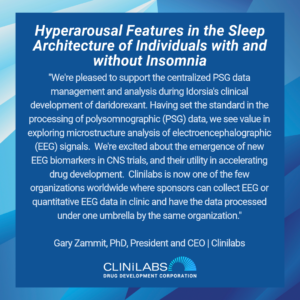 “Hyperarousal Features in the Sleep Architecture of Individuals with and without Insomnia,” analyzed data from 1,710 individuals with insomnia and 1,455 individuals without insomnia. It found that individuals with insomnia showed signs of hyperarousal, including higher likelihood of waking from all sleep stages, increased relative alpha and theta power during certain sleep stages, decreased relative delta power, elevated Wake Electroencephalographic Similarity Index scores, decreased sleep spindle density, and increased spindle dispersion. These findings suggest that insomnia is characterized by a dysfunction in sleep quality with continuous hyperarousal.
“Hyperarousal Features in the Sleep Architecture of Individuals with and without Insomnia,” analyzed data from 1,710 individuals with insomnia and 1,455 individuals without insomnia. It found that individuals with insomnia showed signs of hyperarousal, including higher likelihood of waking from all sleep stages, increased relative alpha and theta power during certain sleep stages, decreased relative delta power, elevated Wake Electroencephalographic Similarity Index scores, decreased sleep spindle density, and increased spindle dispersion. These findings suggest that insomnia is characterized by a dysfunction in sleep quality with continuous hyperarousal.
This study, published in the Journal of Sleep Research, was a productive collaboration of researchers from leading academic medical centers in the US and Europe, Idorsia Pharmaceuticals Ltd, Clinilabs Drug Development Corporation, and Beacon Biosignals.
Gary Zammit, PhD, President and CEO of Clinilabs, commented: “We’re pleased to support the centralized PSG data management and analysis during Idorsia’s clinical development of daridorexant. Having set the standard in the processing of polysomnographic (PSG) data, we see value in exploring microstructure analysis of electroencephalographic (EEG) signals. We’re excited about the emergence of new EEG biomarkers in CNS trials, and their utility in accelerating drug development. Clinilabs is now one of the few organizations worldwide where sponsors can collect EEG or quantitative EEG data in clinic and have the data processed under one umbrella by the same organization.”
